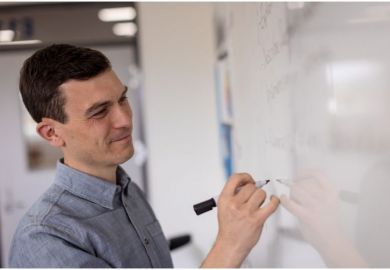One of the beneficial by-products of the collapse of communism has been the resuscitation of the intellectual and moral heritage of eastern and central Europe. The current project of Daniel Murphy of Trinity College, Dublin, is to bring back to public attention the work of three great Slavic educational theorists: Martin Buber, Leo Tolstoy and John Amos Comenius (or Komensky, to give him his Czech family name). This present volume completes the trio.
In recent months the Sheffield Academic Press has published in translation the key sections of one of Comenius's master works, Panorthosia, in which he set out his educational programme under the banner Pansophia. This programme was the principal life-goal of this 17th-century Protestant ecumenist reformer, whose trans-European wanderings, amid the turmoil of the Thirty Years' War, planted his influence everywhere from Poland to England, from Sweden to the Low Countries.
Comenius even turned down an offer of the presidency of Harvard, as he had turned down an insistently offered and lucrative chance to settle in London pressed upon him by Milton's great friend Samuel Hartlib and by resolution of the House of Commons itself.
Murphy's biographical study provides a fascinating glimpse of a highly motivated and highly liberal Protestant at work on an idea, partly inspired by Francis Bacon, to transform the entire educational practice of his day into what we would recognise as a system of child-centred learning. Comenius advocated the abandonment of the barbaric and torturous methods of teaching which were universal in his day and argued that, from the earliest stage of life, the object of education should be the establishment, through the vernacular, of a knowledge of the three Rs plus Latin, music and an extra language.
Character training was to be a chief objective together with the promotion of a pious sense of personal responsibility. Instruction should proceed in stages from known to unknown, grounded in the normal daily experience of the pupil. He went on to design picture-strewn textbooks for adults as well as children. He insisted that education should be universal, free of charge, compulsory and open to children of all creeds.
Together with all the Protestants of Moravia, Comenius was exiled, moving to Poland where he became co-rector of a gymnasium, where his pedagogic theories were tried out and where in 1632 he published a beginner's Latin textbook in which the words and phrases were taught, not from literary models but using only the familiar experiences of everyday life. The Janua Linguarum Reserata became the "golden textbook" of Europe (and America) and remained in use until well into the last century, appearing in every European language, and also in Arabic, Persian, Turkish and Mongolian. (Only the poet Milton found it not to his taste and attacked it in his Tractate on Education.) Bohemia already possessed a tradition of illustrated books and the phenomenal success of Janua was based upon its visual material as much as upon its oral-aural method in which it is virtually indistinguishable from present-day approaches to the teaching of non-vernacular language. But the creation of attractive texts was seen by Comenius as the key to the universal availability of Pansophic education, for the textbook enabled teaching to circumvent or compensate for incompetent teachers. The textbook must impart "the core of full and total wisdom I serving all men's minds in every subject and I permitting through its simplicity easy translation into any language".
The insistence on visual perception as "the surest way to understanding" played a great part in Comenius's advice to the government of Sweden in his Sketch for a Pansophic School, where he advocated covering the walls of the school with pictorial materials. "Now there is nothing in the understanding which was not before in the sense." Comenius repeats this message throughout his extensive writings: nothing can be learned before it is understood and nothing understood before it is recognised and familiar.
Deeply buried in Comenius's ideas are the lessons derived from attempts to impart the Judaeo-Christian scriptures to centuries of children; his approach is steeped in religion. There is a line running from Comenius (and Bacon) to Tolstoy and Froebel which emphasises the integrity and inextricability of the moral, the cultural and the religious. Comenius is separate from that other line of pragmatic, progressive and secular thinking about education which links, say, Rousseau and Dewey. But if you are looking for the roots of Kenneth Baker's view of the national curriculum you are more likely to detect it in Comenius than in Rousseau.
Buber's concern with the "co-intentional dialogue of teacher and pupil" is Comenian, as is Tolstoy's vision of love as the heart of the educational process. The value of Murphy's resurrection of this 17th-century divine is that his book also illuminates and categorises so many strands of 20th-century thinking about education which have become interwoven in our own day into a stodgy liberalism in which many traditions are fused - or fudged.
Comenius settled in Leszno, Poland, together with a community of the Protestant Brethren with whom he had departed his native Moravia. He had dallied in Sweden partly because he had hoped the Swedes would use their muscle to get his community allowed home. But when the Thirty Years' War ended, Roman Catholicism was decreed to be the official religion of the Hapsburg Empire and the brethren lost the freedom of practice which German Protestants could now enjoy. A further round of tragedies ensued for Comenius who had already seen much mayhem and torture, and had endured the loss of his own family to war. Leszno was singled out for anti-Swedish reprisal when Polish troops recaptured it and its inhabitants were put to the sword, some seeking refuge in neighbouring Protestant countries.
Comenius lost his money and his library; his Czech-Latin dictionary, the work of 40 years, disappeared, as well as his unpublished Refutations of Descartes and Copernicus - and all his Pansophic writings. Vast sums were subscribed from all over Europe and a new library was provided. Thirty thousand pounds came from England. Amsterdam gave him a chair where he set about reconstructing his oeuvre, and produced seven prodigious volumes of further Pansophic material. His fame withered, as did the dedication of his promised editors, and the project was abandoned, the seven volumes being rediscovered at the University of Halle only in 1935; the Czech Academy published them in Prague in 1966.
The new translation of Panorthosia (published with a useful preface summarising Comenius's great projects) gives us access to a typical piece of his writing in which he sets out one of his universal schemes to reform education, church and politics through good learning. "The new philosophy will have as its new ultimate goal the reconciliation of disagreements by discovering, establishing, and bringing to light true ideas of everything I There this new philosophy will have to solve all the knotty problems and sophistries of all who have been grievously mistaken, and that without laborious dispute or shocking argument with those who fight on the side of error, but like the Sun melting frozen rivers with the soothing radiance of its light."
Comenius's ideas are paralleled in this century by H. G. Wells whose writings on the idea of World Mind and World Brain have been brought together by Alan Mayne with a comprehensive introduction. Wells wrote at the eve of a war similar to the Thirty Years War in the havoc it wreaked upon Europe, and with some acknowledged debt to the work of Comenius. Wells's scheme was for the reorganisation and rededication of all the reliable information and education available in the world. He wanted the founding of a new social organ or institution "whereby we can solve the jigsaw puzzle and bring all the scattered and ineffective mental wealth of our world into something like a common understanding, and into effective reaction upon our vulgar, everyday political, social and economic life".
The world has now grown irritated with universal schemes; the more brotherhood is preached the more our sceptical hackles rise and, certainly, Wells writes with the verve of a utopian snake-oil salesman, although his idea of using universal forms of knowledge to eradicate mutual suspicions is today enjoying a powerful new vogue among people who see in the computerisation of information the tool of a real utopian politics. Alan Mayne has long worked in this field and uses his introduction to restate the position of 1990s World Brain enthusiasts.
We are so habituated today to seeing education treated as an instrument of wealth creation or for creating voting citizens, or to inculcate correct thinking about culture, politics and self-fulfilment, that it is quite hard at first to read this material with the seriousness it deserves. For Mayne (and Wells) are saying that education, if it uses all the techniques available, could become the means by which some vision of human brotherhood could be given meaning and reality. One has to suspend one's ever-ready prejaundiced scepticism but this reader found himself doing so willingly once entered into the spirit of the discourse. Cybernetic idealism has a place.
Anthony Smith is president, Magdalen College, Oxford.
Comenius: A Critical Reassment of his Life and Work
Author - Daniel Murphy
ISBN - 0 7165 2537 2
Publisher - Irish Academic Press
Price - £30.00
Pages - 294
Register to continue
Why register?
- Registration is free and only takes a moment
- Once registered, you can read 3 articles a month
- Sign up for our newsletter
Subscribe
Or subscribe for unlimited access to:
- Unlimited access to news, views, insights & reviews
- Digital editions
- Digital access to THE’s university and college rankings analysis
Already registered or a current subscriber?



